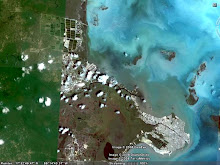
I am in Belize now, and have had a chance to do some field work.
Specifically, I was able to help Eli Romero, a Belizean about to begin graduate school at Boston University. His study examines the movements of fish from the lagoon to sites offshore. This project is similar to one I did in the past, so we have been communicating and collaborating. In the picture above, we are surveying the catch of a local fisherman. Eli bought fish from this fisherman to sample the fish tissues for chemical tracers unique to the lagoon. Habitats like the lagoon are nursery areas for important commercial species like snapper.
By improving shrimp farm effluent quality, we are helping protect this fishery and the livelihood of fishers like this. We are also helping protect biodiversity. Unique fish like the trunk fish juvenile and adult below are common in the lagoon. By preserving seagrass habitat, we help protect their ability to survive.






Wow, those are amazing fish! The juvenile trunk fish is so small it is hard to believe. Today we are meeting, and E. Russell and I are going to the hardware store tonight to look at screens, so that we can test different materials in water.
ReplyDeleteIf you see this today, let me know if you have any suggestions!
Just think about durability, ease of handling and economy.
ReplyDeleteLater on, it may be appropriate to design a unique surface for manufacture. Keep that idea in the back of your head while you're looking at what's readily available now.
I'll post more pictures from Belize soon.
I feel like at the moment we should strive either to be very general in our design or create a variety of designs taylored to availability of resources: especially with reguard to designing our own surface. So our temporary designs must be accomodating.
ReplyDeleteBy "later", do you mean when we have already introduced the product to the effluent canals or when we are more certain of what our product will look like? How plausible will manufacture of a new material be- are we talking huge expense, which would mean only long term payoff for the shrimp farms?
Yes, that's correct, Elizabeth. By "later", I'm thinking that surface type will be more of a finishing stage. We need "proof of concept" at this point.
ReplyDeleteManufacturing can be cost effective at a later stage. It may be too that we can improve our efficiency with a specialized surface, but we're probably not ready to do that yet.